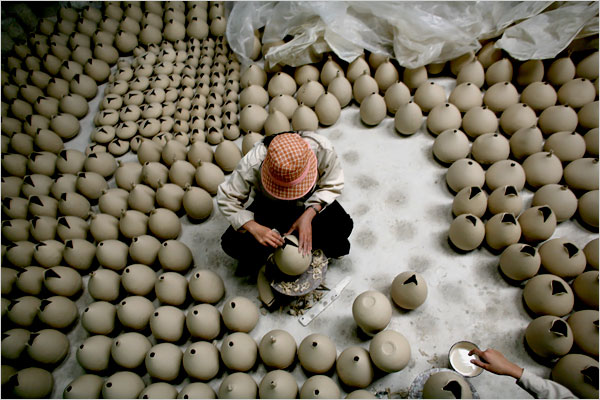Bat Trang Village: Ceramic Capital

In Vietnam, Bat Trang is synonymous with ceramic. A tiny village in the northern part of the country, around 13 kilometers Southeast of Hanoi Center, and on the opposite side of Chuong Duong Bridge, Bat Trang is known for its world-class quality ceramic and pottery products. From vases, bowls, dishes, and many others, the village produces export-quality, hand-made products that marked its name on the map worldwide.
Bat Trang Village has an interesting history to begin with. It is unclear when it was officially established. While some documents record its existence between the 14th and 15th centuries, the local residents themselves claim their village existed earlier than that. The village also has two histories to its claim. One suggests that in 1100, during the Ly Dnasty, a time when Vietnam was independent and at the beginning of its growth, three scholars came back from their mission trip in China armed with ceramic craft industry knowledge they learned in Vietnam and shared it with the people of Bat Trang.
The other history claims Bat Trang came into existence as early as the 10th century, under the reign of King Ly Cong Uan. The king transferred the capital of the country to Thang Long wherein following progress with the establishment and development of the new capital, businessmen and crafters migrated to the place to establish their own work, trade and life in general.Bat Trang is abundant in white clay, thus the seemingly natural inclination to make ceramics as its primary means of livelihood. In fact, from its humble beginnings, the village today has achieved international recognition for its quality and style.
It now caters to aristocratic families and even produces ceramic products for religious purposes. Its clients are as big and varied as the Netherlands, Britain, Portugal, Southeast Aisa, and Japan (under the brand “Kochi”).There are three basic steps to making a ceramic product. The first step is making the product frame. The most suitable type of clay is chosen, treated, then molded into the design desired. It is then decorated and covered with glaze.
The third and final step is baking the product for three days and three nights, setting the temperature between 12000-13000. After baking, the items are brought out, classified, and repaired in case of imperfections or damages. After everything else, the finished product is done and ready for sale.The ceramic products of Bat Trang are divided into three kinds based on its purpose or use. Utilitarian wares include plates, bowls, teacups, kettles, wine bottles, flowerpots, jars, and vases.
They are basically thicker than Chinese wares. Cult wares are lamp stands, candle holders, incense burner, altar boxes, and swords. These are valuable, collector items. Decorative objects like house models, altars, statues, and architectural fixtures, are what the name suggests: for decoration purposes.Aside from its international quality and design, Bat Trang also boasts of its unique glaze that can only be found in the village.
And even with the emergence of new ceramic businesses both locally and internationally, Bat Trang stands out from all the rest with its traditional and historical identity in all its products that make tourists from all over the world come to the place to admire and purchase the world-class, one-of-a-kind ceramic products.









